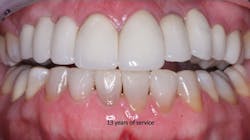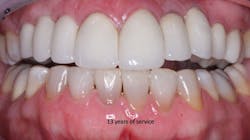Is an implant better than a tooth?
Q: I am beginning to question the previously promoted success statistics on implants after watching many of them in service in the mouth for more than 20 years. In what ways is an implant better than a tooth, and, on the contrary, when is a tooth better than an implant? I would appreciate your clinical opinion and long-term observations.
A: Dental root-form implants were once considered to be the optimum replacement for a tooth. I have lived and practiced through that misconception, and I am pleased to share with you my thoughts based on clinical research projects as well as my personal observations over 30 years of implant placement and restoration. I have placed and restored some implants that looked just like the adjacent natural teeth, and they retained the bone around them without any degeneration. I have also placed and restored implants that were unesthetic and soon began to have peri-implantitis. As you might expect, I have also heroically restored broken-down teeth and placed crowns, only to have the tooth continue with periodontal disease or restoration failure.
Both methods of tooth replacement have their share of failures and successes, which was not the expectation years ago when implants were introduced and rapidly accepted by the profession (figures 1 and 2).In the following narrative, I will compare the realistic characteristics of long-term retention of restored broken-down teeth with that of a restored implant replacing a broken-down tooth that was extracted. Both concepts work when accomplished adequately, but they are very different from each other.
My purpose in comparing the two concepts is to stimulate dentist activity in providing informed consent on these differences to patients before making the decision about tooth removal and implant placement.
Also by Gordon Christensen:
Dental implants versus fixed prostheses
Long-term clinical characteristics of restored broken-down teeth
Dental laboratories report that about 90% of implants placed by US dentists are single-tooth replacements.1
The following information will relate to one or two teeth—not to restoration of a full arch.
- Movement of the tooth in bone when subjected to loading. When a broken-down restored tooth has a load placed on it, the periodontal ligament of the tooth allows significant movement, which is directly related and equivalent to the load applied and the natural movement of the adjacent and opposing teeth. That is not the case with an implant. What is the result of tooth movement with a natural tooth?
- The contact areas remain in the same relationship to adjacent teeth as when originally restored.
- The occlusal contacts are retained as restored.
- The opposing teeth or restorations have the same forces on them as restored.
- Assuming occlusal contacts are adjusted adequately at crown seating, the patient has no occlusal adjustment period and usually cannot tell a difference between the restored tooth or teeth and the adjacent natural teeth.
- The restored tooth or teeth have the same or similar periodontal health condition as the other teeth in the mouth and can receive the same preventive care.
- There is a periodontal ligament attachment to the natural tooth structure.
- Conventional soft-tissue management procedures can be accomplished if the restoration requires replacement.
- The restored tooth or teeth have the same new caries potential as the other teeth in the mouth and must receive the same preventive care as the other teeth.
- The restored tooth may cost less than an implant and crown. A buildup and crown cost about $1,500 today. If endodontic treatment is necessary, the cost is significantly higher.
Long-term clinical characteristics of restored implants
The following characteristics are listed in the same order as those above for restored broken-down teeth.
- Movement of the implant when subjected to loading. When a restored implant has a load placed on it, the osseointegrated implant has only a few microns of movement, which is unrelated and not equivalent to the load applied and the natural movement of the adjacent and opposing teeth. So, what is the result of this difference?
- The contact areas do not remain in the same relationship to adjacent teeth as when originally restored, because the implant does not move in the bone. Natural teeth tend to move mesially, which is known as “mesial drift.” As a result, after a few months or years, the mesial proximal contact of the implant often is now an open contact requiring a somewhat difficult restorative repair.
- The occlusal contacts are not retained as restored since the implant does not move. Because of this, the opposing teeth and the implant restoration need extremely delicate continuing adjustment to avoid traumatizing the opposing teeth or restorations.
- The opposing teeth or restorations do not have the same forces on them as restored. This situation places more force on the opposing teeth or restorations, potentially causing occlusal trauma on the opposing restorations or tooth fracture.
- Assuming occlusal contacts are adjusted adequately at seating of the restoration, the patient still has an occlusal adjustment period and can often tell a difference between the restored implant(s) and the adjacent or opposing natural teeth until the teeth adjust to the nonmoving implant.
- The restored tooth or teeth have the same or similar periodontal health condition as the other teeth in the mouth and can receive the same preventive care. The restored implant does not have the same periodontal relationship as a natural tooth. Originally, it was predicted that implants would not have periodontal disease. It is now known that nearly one-half of restored implants have peri-mucositis or peri-implantitis several years after placement.2
- There is not a periodontal attachment to the implant as there is with natural tooth structure. Therefore, significant care must be taken to avoid damage to the soft tissue on routine prophy appointments or subsequent restorative treatment.
- Conventional soft-tissue management procedures cannot be accomplished if the restoration requires replacement. A modified gentle tissue management technique is necessary to avoid soft-tissue damage around an implant.
- The restored implant does not have the same new caries potential as the other teeth in the mouth and does not have to receive the same chemical preventive care as the other teeth. This is a major advantage for implant placement and one that patients appreciate.
- The restored implant may cost more than building up a broken-down tooth and placing a crown. Today, fees for a tooth removal, an implant, and an implant-supported crown have increased to $3,000–$3,800, depending on whether a separate abutment is used.
Advising patients about the differences between an implant and a tooth
Thorough informed consent should be provided for patients who are considering having a tooth removed and an implant placed as opposed to retaining a broken-down tooth and restoring it. When patients understand the known differences between the characteristics of a retained restored tooth and an implant-supported crown, they will know the two procedures are quite different. This education may influence them in their decision to retain the tooth or have an implant placed and eliminate the chance of new caries.
Careful analysis of teeth versus implants shows that implants do not really have the same characteristics as natural teeth and supports the conclusion that currently there is nothing like a natural tooth.
Summary
Although there is a tendency to believe that dental implants have replaced natural teeth and are better than natural teeth, that assumption needs to be carefully analyzed for each specific clinical situation. This may often be true, but even more often, retention of the natural tooth may be the better clinical choice. Patients deserve thorough informed consent and a candid discussion about the characteristics of each option before deciding which is best for them.
Author’s note: The following educational materials from Practical Clinical Courses offer further resources on this topic for you and your staff.
One-hour videos:
- Diagnosis & Treatment of Failing Implants (Item no. V2391)
- Making Dental Caries Prevention a “Win-Win” Concept (Item no. V5120)
Two-day hands-on course in Utah:
- Restorative Dentistry 2—Fixed Prosthodontics with Dr. Gordon Christensen
- Avoiding Implant Failures and How to Treat Them with Drs. Gordon Christensen, Jon Suzuki, and Kevin Suzuki
For more information, visit pccdental.com or contact Practical Clinical Courses at (800) 223-6569.
References
- Verbal comments from several large labs.
- Derks J, Schaller D, Håkansson J, Wennström JL, Tomasi C, Berglundh T. Effectiveness of implant therapy analyzed in a Swedish population: prevalence of peri-implantitis. J Dent Res. 2016;95(1):43-49. doi:10.1177/0022034515608832
Editor's note: This article appeared in the October 2021 print edition of Dental Economics
Gordon J. Christensen, DDS, PhD, MSD, is a practicing prosthodontist in Provo, Utah. He is the founder and CEO of Practical Clinical Courses, an international continuing education organization founded in 1981 for dental professionals. Dr. Christensen is cofounder (with his wife, Rella Christensen, PhD, RDH) and CEO of Clinicians Report.
About the Author

Gordon J. Christensen, DDS, PhD, MSD
Gordon J. Christensen, DDS, PhD, MSD, is founder and CEO of Practical Clinical Courses and cofounder of Clinicians Report. His wife, Rella Christensen, PhD, is the cofounder. PCC is an international dental continuing education organization founded in 1981. Dr. Christensen is a practicing prosthodontist in Provo, Utah.


